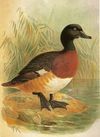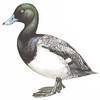Genus Aythya

Lesser Scaup - Aythya affinis, the Lesser Scaup , is a small North American diving duck that migrates south as far as Central America in winter. It is colloquially known as the Little Bluebill or Broadbill. It is apparently a very close relative of the Holarctic Greater Scaup or "bluebill" , with which it forms a superspecies.
Redhead - The adult male has a blue bill, a red head and neck, a black breast, yellow eyes and a grey back. The adult female has a brown head and body and a darker bluish bill with a black tip.
White-eyed Duck - Like the other members of the pochard group, Hardheads feed by diving deeply, often staying submerged for as long as a minute at a time. They slip under the water with barely a ripple, simply lowering their heads and thrusting with their powerful webbed feet. They eat a broad range of small aquatic creatures, and supplement this with water weeds.
Baer's Pochard - It is similar in size and stance to its close relative the Ferruginous Duck , although the coloration of the drakes is entirely different. Baer's Pochard males are similar to those of the Greater Scaup , but have a dark back and upper flanks; the white lower flanks and belly are conspicuous. The females of Baer's Pochard and the Ferruginous Duck are quite similar, but that holds true for the females of almost all Aythya species.
Ring-necked Duck - The adult male is similar in color pattern to the Eurasian Tufted Duck, its relative. It has a grey bill with a white band, a shiny purple head, a white breast, yellow eyes and a dark grey back. The adult female has a pale brown head and body with a dark brown back, a dark bill with a more subtle light band than the male and brown eyes. The cinnamon neck ring is usually difficult to observe, unlike the white ring on its bill, which is why the bird is sometimes referred to as a "ringbill".
Pochard - The adult male has a long dark bill with a grey band, a red head and neck, a black breast, red eyes and a grey back. The adult female has a brown head and body and a narrower grey bill band. The triangular head shape is distinctive. Pochards are superficially similar to the closely related North American Redhead and Canvasback.
Tufted Duck - The adult male is all black except for white flanks and a blue-grey bill. It has an obvious head tuft that gives the species its name. The adult female is brown with paler flanks, and is more easily confused with other diving ducks. In particular, some have white around the bill base which resembles the scaup species, although the white is never as extensive as in those ducks.
Madagascar Pochard - Based on the accounts written by Webb and Delacour's in the 1920s and 1930s it seemed that the bird was still relatively common at Lake Alaotra .
Greater Scaup - The Greater Scaup , just Scaup in Europe, or colloquially known as "Bluebill", is a small diving duck. It breeds on the ground by lakes and bogs on the tundra and at the northern limits of the boreal forest across Arctic and subarctic regions of northern North America, Europe and Asia.
New Zealand Scaup - Overall dark brown/black colours. The male has a striking yellow eye and a dark coloured head. The female is similar to the male, but without the yellow eye and has a white face patch during breeding season. A white wing bar can be seen in both sexes when in flight .
Ferruginous Duck - Their breeding habitat is marshes and lakes with a metre or more water depth. These ducks breed in southern and eastern Europe and southern and western Asia. They are somewhat migratory, and winter farther south and into north Africa.
Canvasback - The Canvasback , is a large North American diving duck, that ranges from between 48–56 cm long and weighs approximately 862-1588 g, with a wingspan of 79-89 cm. The adult male has a black bill, a chestnut red head and neck, a black breast, a grayish back, black rump, and a blackish brown tail. The sides, flank, and belly are white while the wing coverts are grayish and vermiculated with black. The bill is blackish and the legs and feet are bluish-gray. The iris is bright red in the spring, but duller in the winter. The adult female has a light brown head and neck, grading into a darker brown chest and foreback. The sides, flanks, and back are grayish brown. The bill is blackish and the legs and feet are bluish-gray. Its sloping profile distinguishes it from other ducks.











